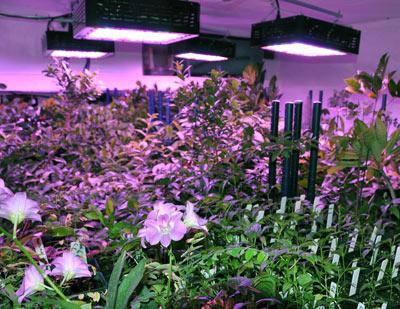Lumens: Why They're Not That Important

Luminous flux is a measure of the amount of light that is visible to the human eye, and lumens are the unit used to describe this measurement. So, why don't lumens matter when it comes to growing plants? Basically, lumens will show you how well a human eye will be able to see under a given light source... but plants don't have human eyes.
Plants have a variety of pigments that use the energy in light to convert carbon dioxide and water into sugars (this process is known as photosynthesis). Different pigments use different wavelengths of light to accomplish this task: Chlorophyll a absorbs red and dark blue light; Chlorophyll b absorbs orange and light-blue light; Carotenoids absorb blue, purple, and ultraviolet (UV) light; and green/yellow light is essential for phytochrome response. While there is some overlap between the wavelengths of light useful to the human eye and those useful to plants for photosynthesis, different wavelengths are more important for each function. For example, the human eye is most sensitive to yellow light, so the measure of lumens is weighted with respect to that particular range of wavelengths, while photosynthetic plants make the most use of red and blue light. Another important consideration is that many plants utilize non-visible wavelengths of light. For example, UV light stimulates the production of defensive chemical compounds in many plants and specifically trichome and terpenoid production in cannabis. Lumens don't provide any information about the UV or far red (FR / NIR) or infrared (IR) content of a light source.
So, what should you look for in a plant grow light, if not lumens? Lumens will give you some information about the power of a light source, but it is more important to pay attention to the combination of Photosynthetically Active Radiation (PAR) and Yield Photon Flux (YPF). Measured in micromoles per second and per square meter ( µmol s-1m-2), PAR shows how many photons in the 400 to 700 nanometer (nm) range of wavelengths are being emitted by a light source. The number of photons emitted is useful because photosynthesis takes place when a photon of light is absorbed by a reaction center located inside a photosynthetically active pigment. PAR still isn't a perfect measure of how a grow light will perform. Click here to visit our FAQ and learn more. YPF is a weighted measure of photon flux between 350 and 800 nm, meaning that it takes into account which exact wavelengths of light are most useful to plants and assigns those wavelengths a greater value of usefulness. YPF includes wavelengths outside of the visible range of light, which can cause the production of useful chemical compounds in some plants. While YPF is better than PAR and vastly better than lumens for evaluating grow lights, it still has shortcomings as well. A combination of wavelengths, including outside the visible range, is beneficial when growing plants under artificial light.
At Black Dog LED, lumens are the last aspect under consideration when we design our grow lights. We have a saying: "stop using street lights, and start using plant lights" and that idea is behind the construction of all of our lights. Our proprietary Phyto-Genesis Spectrum® is based on a combination of PAR, YPF, and years of experience growing plants with LED lights -- a combination that has led us to create the best grow lights available.






